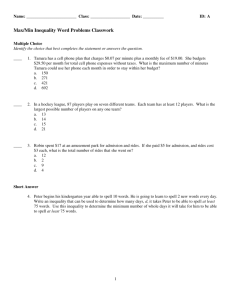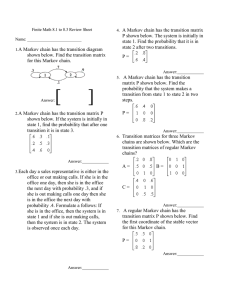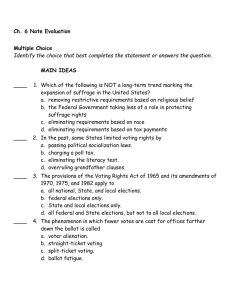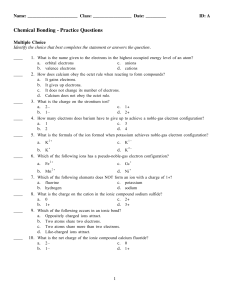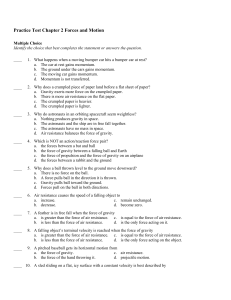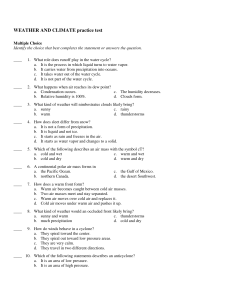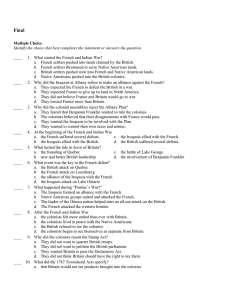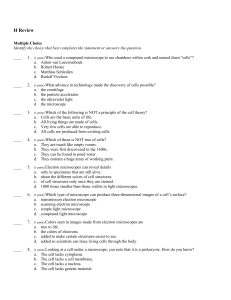Combined Review
advertisement
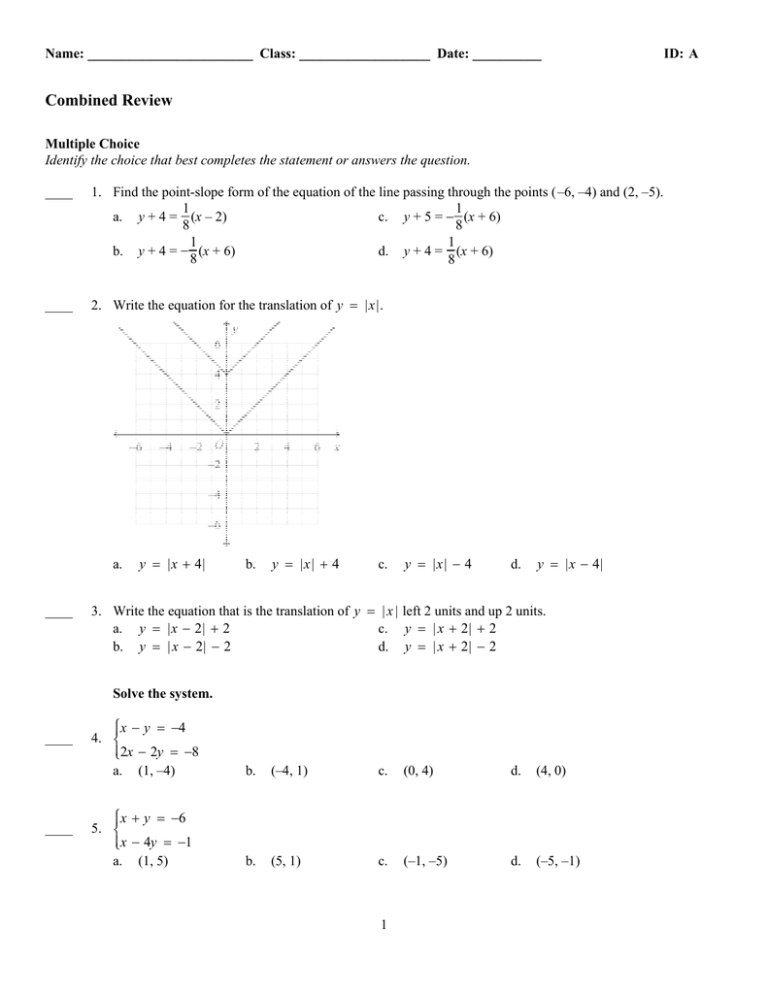
Name: ________________________ Class: ___________________ Date: __________ Combined Review Multiple Choice Identify the choice that best completes the statement or answers the question. ____ 1. Find the point-slope form of the equation of the line passing through the points (–6, –4) and (2, –5). 1 1 a. y + 4 = (x – 2) c. y + 5 = − (x + 6) 8 8 1 1 d. y + 4 = (x + 6) b. y + 4 = − (x + 6) 8 8 ____ 2. Write the equation for the translation of y = | x | . a. ____ y = | x + 4| b. y = |x | + 4 c. y = |x | − 4 d. y = | x − 4| 3. Write the equation that is the translation of y = | x | left 2 units and up 2 units. a. y = | x − 2 | + 2 c. y = | x + 2| + 2 b. y = | x − 2| − 2 d. y = | x + 2| − 2 Solve the system. ____ ____ ÔÏÔ x − y = −4 4. ÔÔÌ ÔÔ 2x − 2y = −8 Ó a. (1, –4) b. (–4, 1) c. (0, 4) d. (4, 0) ÔÏÔ x + y = −6 5. ÔÔÌ ÔÔ x − 4y = −1 Ó a. (1, 5) b. (5, 1) c. (–1, –5) d. (–5, –1) 1 ID: A Name: ________________________ ____ ____ ____ ____ ÏÔ Ô 4x + 2y = 20 6. ÔÌÔ ÔÔ 7x − 3y = 9 Ó a. (4, 3) b. ID: A (–3, –4) ÏÔ Ô −x − 3y = 4 7. ÔÌÔ ÔÔ x + 3y = 7 Ó a. (–7, –8) b. (7, 8) c. (3, 4) c. d. infinite solutions no solutions 8. A system of two linear inequalities ____ has a solution. a. always b. sometimes d. c. (–4, –3) never 9. Given the system of constraints, name all vertices. Then find the maximum value of the given objective function. ÏÔ ÔÔ x ≥ 0 ÔÔ Ôy ≥ 0 Ô ÌÔÔ ÔÔ 6x − 2y ≤ 12 ÔÔ ÔÔ 4y ≤ 4x + 8 Ó Maximum for C = 4x − 3y a. (0, 2), (2, 0), (4, 6); maximum value of –6 b. (0, 2), (2, 0), (6, 4); maximum value of 12 c. (0, 2), (2, 0), (4, 2); maximum value of 10 d. (0, 2), (2, 0), (4, 6); maximum value of 8 ____ 10. Dalco Manufacturing estimates that its weekly profit, P, in hundreds of dollars, can be approximated by the formula P = −3x 2 + 6x + 10, where x is the number of units produced per week, in thousands. a. How many units should the company produce per week to earn the maximum profit? b. Find the maximum weekly profit. a. b. 1,000 units; $1300 3,000 units; $100 c. d. 2 1,000 units; $600 2,000 units; $1100 Name: ________________________ ____ 11. Which is the graph of y = −2(x − 2) 2 − 4? a. b. ID: A c. d. 3 Name: ________________________ ID: A ____ 12. Use vertex form to write the equation of the parabola. a. b. y = 3(x − 2) 2 + 2 y = 3(x − 2) 2 − 2 c. d. y = 3(x + 2) 2 + 2 y = (x + 2) 2 + 2 ____ 13. Identify the vertex and the y-intercept of the graph of the function y = −3(x + 2) 2 + 5. a. vertex: (–2, 5); c. vertex: (2, 5); y-intercept: –7 y-intercept: –7 b. vertex: (2, –5); d. vertex: (–2, –5); y-intercept: –12 y-intercept: 9 Factor the expression. ____ 14. 4x 2 + 20x + 25 a. (2x − 5) 2 b. (2x + 5) c. 2 d. ____ 15. 4x 2 − 25 a. (−2x + 5)(2x − 5) b. (2x − 5) d. (2x + 5)(−2x − 5) (2x + 5)(2x − 5) c. 10, − c. 2 (2x + 5)(−2x − 5) (−2x + 5) 2 ____ 16. Solve by factoring. 4x 2 − 30x − 100 = 0 a. 10, 4 b. –10, 2 5 4 5 2 d. 5 2 − , 2 5 Name: ________________________ ID: A Solve the equation by finding square roots. ____ 17. 3x 2 = 21 − 21 21 c. − 7, d. 7 ____ 18. (−2 + i) + (−2 − 2i) a. −4 − i b. 4 + i c. d. −5i −1 − 4i ____ 19. (1 + 3i) − (6 + 2i) a. 5 − i b. −4i c. d. 7 + 5i −5 + i c. –32 c. d. 10 − 20i 10 − 30i a. b. 3 7, – , 3 7 21 Simplify the expression. ____ 20. (−8i)(4i) a. 32 b. 32i ____ 21. (−5 − 5i)(−2 + 6i) a. −20 − 20i b. 40 − 20i d. –32i d. 0 Solve the equation. ____ 22. 36x 2 + 9 = 0 a. −2i, 2i c. b. 1 1 − , 2 2 d. ____ 23. a. x + 9 − 10 = −7 –6 ____ 24. x 2 + 4x − 3 = 0 a. −2 ± 7 b. −4 ± 11 b. 18 1 − i, 4 1 − i, 2 1 i 4 1 i 2 c. 9 c. 16 ± 7 2 ± 11 d. 5 Name: ________________________ ____ 25. x 2 + 6x + 16 = 0 a. 36 ± i 7 b. 3±i 2 ID: A c. d. −3 ± i 7 −6 ± 2 ____ 26. −2x 2 + x + 8 = 0 a. 1 ± 4 65 4 c. 1 ± 2 65 2 b. 4± 130 4 d. 1 ± 4 32 2 ____ 27. Find the zeros of y = x(x + 4)(x + 3). Then graph the equation. c. 0, –4, –3 a. –4, –3, 4 b. 0, 4, 3 d. 6 –4, –3 Name: ________________________ ID: A ____ 28. Write a polynomial function in standard form with zeros at 5, –3, and 1. c. f(x) = x 3 − 3x 2 − 13x − 8 a. f(x) = x 3 − 16x 2 + 30x − 8 b. f(x) = x 3 − 3x 2 − 13x + 15 d. f(x) = x 3 + 15x 2 − 3x − 13 ____ 29. Find the zeros of f(x) = (x + 5) 2 (x − 4) 4 and state the multiplicity. a. –5, multiplicity 2; 4, multiplicity 4 b. 2, multiplicity –5; 4, multiplicity 4 c. 2, multiplicity –5; 4, multiplicity 4 d. –5, multiplicity 2; 4, multiplicity 4 ____ 30. Divide −x 3 − x 2 + 2x − 4 by x + 3. a. −x 2 − 4x + 8, R –16 b. −x 2 − 4x + 8 ____ 31. Divide a. b. c. d. (x 4 + 20x 3 + 34x 2 − 66x − 45) ÷ (x + 3) x 3 − 17x 2 − 15x + 17 c. x 3 + 17x 2 − 17x − 15 d. −x 2 + 2x − 4 −x 2 + 2x − 4, R 8 x 3 − 14x 2 + 68x − 36 x 3 + 20x 2 − 14x − 36 Simplify the radical expression. Use absolute value symbols if needed. ____ 32. 4 625x 20 y 8 a. 25 |x 25 |y 4 b. 25x 25 | y 4 | c. 5x 5 | y 2 | d. 5 |x 5 |y 2 c. 3 5 d. not possible c. 11 4 −11 d. not possible Multiply and simplify if possible. ____ 33. ____ 34. 15 ⋅ 5 a. 5 3 b. 11 ⋅ 4 −11 a. –11 b. 75 4 b. 3 135a 10 b 9 . Assume that all variables are positive. 3a 3 b 5a c. 3a 3 b 3 a 5a 3 b 3 3 3a d. none of these ____ 35. Simplify a. 11 33 7 Name: ________________________ ID: A Simplify. ____ 36. − 6 +6 9 +4 6 a. 3 6 + 18 b. 3 6 + 6 9 c. d. −3 6 + 18 none of these Multiply. Ê ˆÊ ____ 37. ÁÁÁ 7 − 3 ˜˜˜ ÁÁÁ 8 + Ë ¯Ë a. 59 + 56 3 b. 53 − ˆ 3 ˜˜˜ ¯ d. 53 + 56 3 12 + 15 3 c. −1 c. 3 Solve. Check for extraneous solutions. ____ 38. 5x = a. 20 − 5x 4 − 5 b. 4 and −1 5 ____ 39. Let f(x) = 3x + 5 and g(x) = 4x + 7. Find f(x) + g(x). b. 7x + 12 c. 7x – 2 a. –x + 12 d. 4 5 d. –x – 2 d. –20 ____ 40. Let f(x) = 3x + 2 and g(x) = −7x − 6. Find f ⋅ g and its domain. 6 a. −21x 2 − 32x − 12; all real numbers except x = − 7 2 b. 6x − 4x + 42; all real numbers 2 c. 6x 2 − 4x + 42; all real numbers except x = − 3 2 d. −21x − 32x − 12; all real numbers ____ 41. Let f(x) = −4x − 5 and g(x) = −2x − 6. Find (f û g)(−3). b. 0 c. 7 a. –5 Write the equation in logarithmic form. ____ 42. 7 2 = 49 a. log 7 49 = 2 b. log 2 49 = 7 c. d. 8 log 49 = 2 ⋅ 7 log 49 = 2 Name: ________________________ ID: A Evaluate the logarithm. 1 25 2 b. 5 c. –2 d. –1 ____ 44. log 7 343 a. –3 b. 2 c. 3 d. 7 d. log 70 ____ 48. Solve ln(3x − 1) = 1. Round to the nearest thousandth. a. 3.052 b. 1.718 c. 0.573 d. 1.239 ____ 49. Solve ln 2 + ln x = 5. a. 50,000 b. d. 3 ____ 43. log 5 a. Write the expression as a single logarithm. ____ 45. 4 log b v + 3 log b x a. log b (v 4 x 3 ) c. b. (4 + 3) log b (v + x) d. ____ 46. log 2 80 − log 2 10 a. log 2 8 b. log 8 Ê ˆ log b ÁÁ vx 4 + 3 ˜˜ Ë ¯ ÊÁ 4 ˆ log b Á v + x 3 ˜˜ Ë ¯ c. log 2 70 c. log 7 2 − log 7 n d. −n log 7 2 Expand the logarithmic expression. ____ 47. log 7 a. b. n 2 log 7 n − log 7 2 log7 n log7 2 74.2 c. 10 Simplify the rational expression. State any restrictions on the variable. ____ 50. a 2 + 3a − 28 a. b. a+7 −a + 4; a ≠ −7 a − 4; a ≠ −7 c. d. 9 a + 4; a ≠ 7 −a − 4; a ≠ 7 Name: ________________________ ID: A Multiply or divide. State any restrictions on the variables. ____ 51. g 2 − 3g − 10 g2 ⋅ g 2 − 6g g+2 g−5 , g ≠ −2, 6 a. g−6 g 2 − 5g b. c. , g ≠ −2, 6 g−6 d. g−5 g−6 , g ≠ −2, 0, 6 g 2 − 5g g−6 , g ≠ −2, 0, 6 Add or subtract. Simplify if possible. ____ 52. 4 g−9 a. b. + 1 g − 81 5 2 c. g + g − 90 4g − 35 (g − 9)(g + 9) 2 d. 5 (g − 9)(g + 9) 4g + 37 (g − 9)(g + 9) Solve the equation. Check the solution. ____ 53. ____ 54. −2 = x−4 26 a. 7 y+7 y−8 85 a. 12 = 5 x−3 b. 13 b. − c. 17 7 c. − d. 20 7 d. − y+8 y−3 85 12 10 85 4 43 4 Name: ________________________ ID: A Short Answer 55. Graph the system of constraints. Then find the values of x and y that maximize P = 40x + 30y. ÏÔ ÔÔ x ≥ 0 ÔÔ ÔÔ y ≥ 0 ÌÔÔ ÔÔÔ −2x + 2y ≤ 4 Ô ÔÓÔ x ≤ 3 56. Graph y = 2x 2 − 7. 57. In a baseball game, an outfielder throws a ball to the second baseman. The path of the ball is modeled by the 2 705 1 ÊÁÁ 375 ˆ˜˜ ˜ Á equation y = − 900 Á x − 2 ˜ + 16 , where y is the height of the ball in feet after the ball has traveled x ˜¯ ÁË feet horizontally. The second baseman catches the ball at the same height as the height at which the outfielder released it. a. What was the maximum height of the ball along its path? Answer to the nearest foot. b. How far was the second baseman from the outfielder at the time he caught the ball? c. How high above the ground was the ball when it left the hand of the outfielder? 58. Use the graph of y = (x − 3) 2 + 5. a. If you translate the parabola to the right 2 units and down 7 units, what is the equation of the new parabola in vertex form? b. If you translate the original parabola to the left 2 units and up 7 units, what is the equation of the new parabola in vertex form? c. How could you translate the new parabola in part (a) to get the new parabola in part (b)? 11 Name: ________________________ ID: A x−2 and g(x) = 2x 2 + 4. 4 a. Find f(g(x)). b. Find g(f(x)). 59. Let f(x) = Essay 60. A model for the height of a toy rocket shot from a platform is y = −16x 2 + 145x + 7, where x is the time in seconds and y is the height in feet. a. Graph the function. b. Find the zeros of the function. c. What do the zeros represent? Are they realistic? d. About how high does the rocket fly before hitting the ground? Explain. 12 ID: A Combined Review Answer Section MULTIPLE CHOICE 1. ANS: OBJ: TOP: 2. ANS: OBJ: TOP: 3. ANS: OBJ: TOP: 4. ANS: OBJ: TOP: KEY: 5. ANS: OBJ: TOP: KEY: 6. ANS: OBJ: TOP: KEY: 7. ANS: OBJ: TOP: KEY: 8. ANS: OBJ: KEY: 9. ANS: OBJ: TOP: KEY: 10. ANS: OBJ: TOP: KEY: 11. ANS: OBJ: TOP: 12. ANS: OBJ: TOP: KEY: B PTS: 1 DIF: L2 REF: 2-2 Linear Equations 2-2.2 Writing Equations of Lines STA: CO 2.1 | CO 2.2 | CO 2.4 | CO 2.5 | CO 2.6 2-2 Example 5 KEY: point-slope form | ordered pair B PTS: 1 DIF: L2 REF: 2-6 Families of Functions 2-6.1 Translating Graphs STA: CO 2.3 | CO 2.4 | CO 4.7 2-6 Example 1 KEY: horizontal translation | vertical translation C PTS: 1 DIF: L2 REF: 2-6 Families of Functions 2-6.1 Translating Graphs STA: CO 2.3 | CO 2.4 | CO 4.7 2-6 Example 2 KEY: horizontal translation C PTS: 1 DIF: L2 REF: 3-2 Solving Systems Algebraically 3-2.1 Solving Systems by Substitution STA: CO 2.1 3-2 Example 1 system of linear equations | substitution method D PTS: 1 DIF: L2 REF: 3-2 Solving Systems Algebraically 3-2.2 Solving Systems by Elimination STA: CO 2.1 3-2 Example 3 system of linear equations | solve by elimination C PTS: 1 DIF: L2 REF: 3-2 Solving Systems Algebraically 3-2.2 Solving Systems by Elimination STA: CO 2.1 3-2 Example 4 system of linear equations | solve by elimination | equivalent systems D PTS: 1 DIF: L2 REF: 3-2 Solving Systems Algebraically 3-2.2 Solving Systems by Elimination STA: CO 2.1 3-2 Example 5 system of linear equations | solve by elimination | no solutions B PTS: 1 DIF: L4 REF: 3-3 Systems of Inequalities 3-3.1 Solving Systems of Inequalities STA: CO 2.1 | CO 2.5 system of inequalities | reasoning | always sometimes never D PTS: 1 DIF: L3 REF: 3-4 Linear Programming 3-4.1 Finding Maximum and Minimum Values STA: CO 2.8 3-4 Example 1 linear programming | constraints | vertices | objective function | maximum value A PTS: 1 DIF: L3 REF: 5-2 Properties of Parabolas 5-2.2 Finding Maximum and Minimum Values STA: CO 2.4 | CO 2.5 5-2 Example 4 maximum value | word problem | problem solving | multi-part question A PTS: 1 DIF: L2 REF: 5-3 Translating Parabolas 5-3.1 Using Vertex Form STA: CO 2.4 | CO 2.5 | CO 4.1 5-3 Example 1 KEY: graphing | translation C PTS: 1 DIF: L2 REF: 5-3 Translating Parabolas 5-3.1 Using Vertex Form STA: CO 2.4 | CO 2.5 | CO 4.1 5-3 Example 2 parabola | equation of a parabola | vertex form 1


